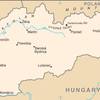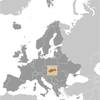Slovakia [+]Compare [E]dit [H]istory
Aliases: Slovak Republic, Slovenska republika, SlovenskoObject «Slovakia» was created due to
Add new object to «Slovakia» or move existing objects here.
Object «Slovakia» has attributes [Show empty attributes][Hide empty attributes]
| Attribute | Value |
|---|---|
| Geography | |
| Area | 49,035 km² |
| Continent | Europe |
| Land area | 48,105 km² |
| Water area | 930 km² |
| Land boundaries | 1,611 km |
| Border countries |
|
| Coastline | 0 km |
| Mean elevation | 458 m |
| Lowest point | 94 m |
| Highest point | 2,655 m |
| People | |
| Population | 5,440,602 |
| Official languages |
|
| Religion | Roman Catholic |
| Government | |
| Long country name | Slovak Republic |
| Short country name | Slovakia |
| Long local name | Slovenska republika |
| Short local name | Slovensko |
| Former name | Add |
| Government type | Parliamentary republic |
| Capital | Bratislava |
| Economy | |
| GDP (PPP) | 179,700,000,000 USD |
| GDP (OER) | 95,960,000,000 USD |
| GDP (real growth rate) | 3.4 % |
| GDP - per capita (PPP) | 33,100 USD |
| Gross national saving | 20.6 % of GDP |
| Labor force | 2,758,000 |
| Unemployment rate | 8.1 % |
| Population below poverty line | 12.3 % |
| Budget revenues | 37,790,000,000 USD |
| Budget expenditures | 38,790,000,000 USD |
| Military expenditures | 1.74 % of GDP |
| Taxes and other revenues | 39.4 % of GDP |
| Budget surplus or deficit | -1 % of GDP |
| Public debt | 50.9 % of GDP |
| Inflation rate | 1.3 % |
| Central bank discount rate | 0 % |
| Commercial bank prime lending rate | 2.44 % |
| Stock of narrow money | 56,460,000,000 USD |
| Stock of broad money | 56,460,000,000 USD |
| Stock of domestic credit | 85,560,000,000 USD |
| Market value of publicly traded shares | 4,567,000,000 USD |
| Current account balance | -2,005,000,000 USD |
| Exports | 80,800,000,000 USD |
| Imports | 80,070,000,000 USD |
| Reserves of foreign exchange and gold | 3,622,000,000 USD |
| External debt | 75,040,000,000 USD |
| National currency | euros |
| National currency (code) | EUR |
| National currency (symbol) | € |
| National currency rate to USD | 0.885 |
Slovakia traces its roots to the 9th century state of Great Moravia. Subsequently, the Slovaks became part of the Hungarian Kingdom, where they remained for the next 1,000 years. After the formation of the dual Austro-Hungarian monarchy in 1867, backlash to language and education policies favoring the use of Hungarian (Magyarization) encouraged the strengthening of Slovak nationalism and a cultivation of cultural ties with the closely related Czechs, who fell administratively under the Austrian half of the empire. After the dissolution of the Austro-Hungarian Empire at the close of World War I, the Slovaks joined the Czechs to form Czechoslovakia. The new state was envisioned as a nation with Czech and Slovak branches. During the interwar period, Slovak nationalist leaders pushed for autonomy within Czechoslovakia, and in 1939 Slovakia became an independent state created by and allied with Nazi Germany. Following World War II, Czechoslovakia was reconstituted and came under communist rule within Soviet-dominated Eastern Europe. In 1968, an invasion by Warsaw Pact troops ended the efforts of Czechoslovakia's leaders to liberalize communist rule and create "socialism with a human face," ushering in a period of repression known as "normalization." The peaceful "Velvet Revolution" swept the Communist Party from power at the end of 1989 and inaugurated a return to democratic rule and a market economy. On 1 January 1993, Czechoslovakia underwent a nonviolent "velvet divorce" into its two national components, Slovakia and the Czech Republic. Slovakia joined both NATO and the EU in the spring of 2004 and the euro zone on 1 January 2009.
Similar objects
Most often compared with
Everyone can something to edit or add.
There were 2 edits, no edits waiting approval. Last edited by Guest_1196(-101), May 26, 2020 (49 fields were changed)
Help · Contact us · Disclaimer · Contributors · Developers · Donate


